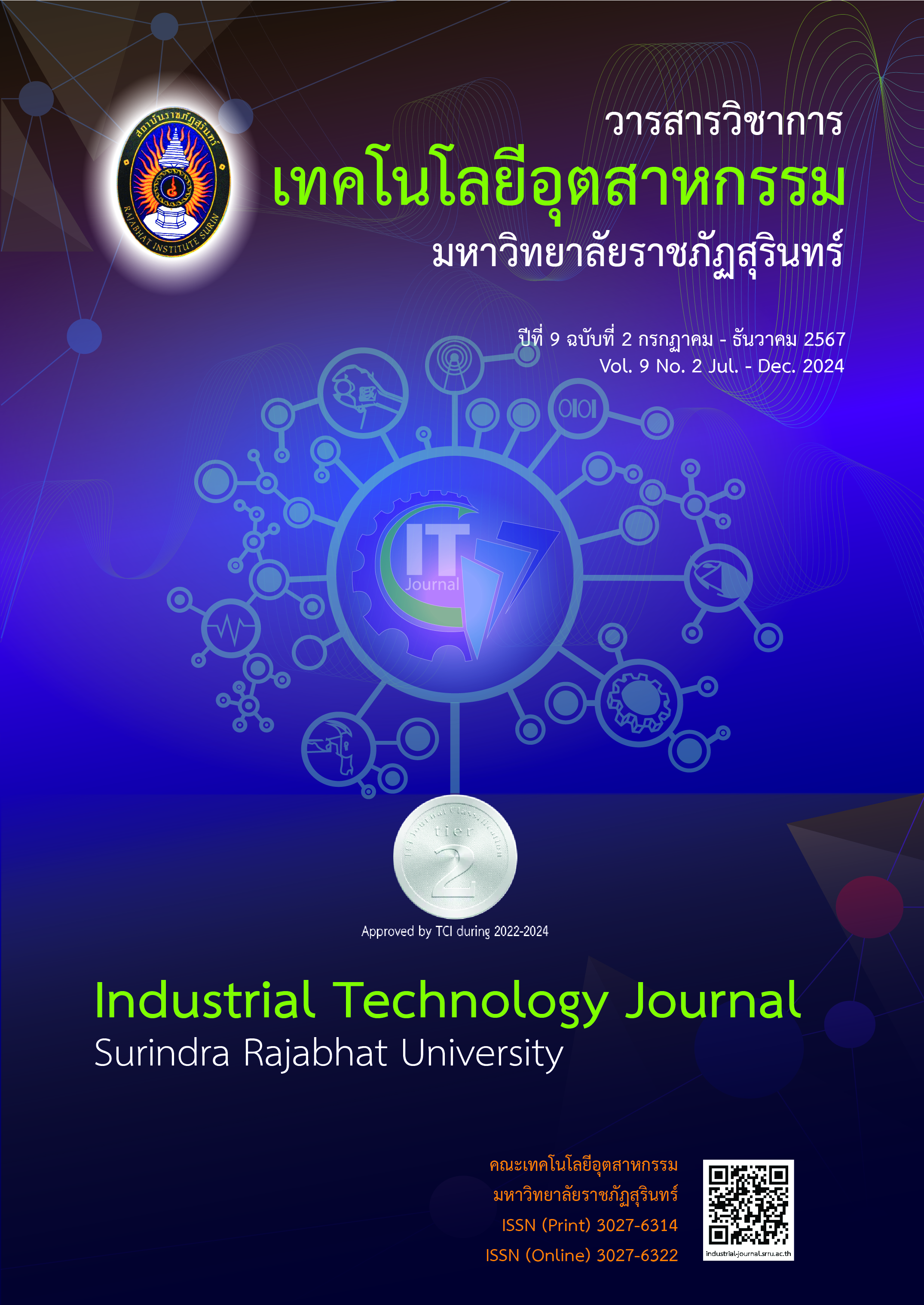Assessment of the Feasibility of Small Wind Turbines for Electricity Generation within Buriram Rajabhat University
Main Article Content
Abstract
This research investigates the feasibility of harnessing electricity from small, low-speed wind turbines as a means of utilizing clean energy without environmental pollution. The objectives include designing and constructing a wind power generator and assessing the electricity production capabilities of both vertical and horizontal wind turbines. The generator is comprised of 48 permanent magnetic discs encased in resin for the rotor, while the stator winding consists of copper coils (23 AWG, 10 coils with 1,500 turns per coil). Wind turbine blades are designed to suit low wind speeds, with a vertical axis wind turbine utilizing a roof ventilation fan with 36 petals, each 60 cm in diameter and 50 cm in height, and a horizontal axis wind turbine constructed from plastic pipes of varying lengths are consists 60 cm, 80 cm, and 100 cm.
The experiment compares electricity production between the two turbine types, revealing notable differences. The horizontal axis blades, particularly those with an 80 cm length, demonstrate superior electricity generation capabilities under specific conditions: at a height of 6 meters, wind speed of 4 meters per second, and 358 revolutions per minute, producing a voltage of 40.67 volts. Conversely, the vertical axis turbine achieves optimal performance at the same height and wind speed but with 64 revolutions per minute, yielding a voltage of 26.54 volts. Minimum voltage outputs are recorded at a height of 2 meters and wind speed of 1.1 meters per second for both turbine types. These findings provide valuable insights into the potential of wind turbines as alternative energy sources for electricity generation and offer guidance for further development in this field.
Article Details
References
ธวัชชัย อัตถวิบูลย์กุล. (2546). เครื่องกลไฟฟ้า1. กรุงเทพฯ : ศูนย์ส่งเสริมอาชีวะ.
พงษ์เทพ นามศิริ (2552). การประยุกต์ใช้กังหันลมขนาดเล็ก 200 W เพื่อผลิตพลังงานทดแทนบนไซโล
กรณีศึกษาของบริษัทKatoen Natie Services (Thailand) Ltd. การค้นคว้าอิสระ สาขาการบริหารเทคโนโลยี วิทยาลัยนวัตกรรม, มหาวิทยาลัยธรรมศาสตร์.
พงษ์เทพ นามศิริ (2552). การประยุกต์ใช้กังหันลมขนาดเล็ก 200 W เพื่อผลิตพลังงานทดแทนบนไซโล
กรณีศึกษาของบริษัทKatoen Natie Services (Thailand) Ltd. การค้นคว้าอิสระ สาขาการบริหารเทคโนโลยี วิทยาลัยนวัตกรรม, มหาวิทยาลัยธรรมศาสตร์.
ไมตรี พลสงคราม, ปรีชา ขันติโกมล และ ภัสส์กุญช์ ฐิติมหัทธนกุศล. (2557) “การศึกษาเชิงทดลองต้นแบบกังหันลม
แกนตั้งแบบใบปรับมุมพิทช์ด้วยกลไกแบบ 4 ชิ้น” การประชุมวิชาการรูปแบบพลังงานทดแทนสู่ชุมชนแห่งประเทศไทยครั้งที่ 7. ประจวบคีรีขันธ์, 12-14พฤศจิกายน 2557, หน้า. 642-649.
วิรชัย โรยนรินทร์. (2551). รายงานการศึกษาวิจัยพัฒนาสาธิต ต้นแบบเทคโนโลยีกังหันลมผลิตไฟฟ้าความเร็ว
ลมต่ำ. มทร.ธัญบุรี, กรมการพัฒนาพลังงานทดแทนและอนุรักษ์พลังงาน กระทรวงพลังงาน, 2551.
เสริมศักดิ์ ทิพย์วงศ์. (2556). “กังหันลมผลิตไฟฟ้าสำหรับการส่องสว่างภายนอกอาคาร”, รายงานการวิจัยฉบับ
สมบูรณ์, มหาวิทยาลัยราชภัฏเพชรบูรณ์.
A.K. Wright and D.H. Wood. (2004). The starting and low wind speed behavior of a small
Horizontal axis wind turbine. J. Wind Eng. Ind. Aerod. 92, 2004, pp. 1265-1279.
D. Wood. (2011).Small Wind Turbines. Analysis, Design, and Application. Springer. London. E.Hau. (2013). Wind Turbines:Fundamentals, Technologies, Application, Economics. Springer-
Verlag Berlin.
Islam, S.M., Nayar, C.V., Abu-Siada, A. and Hasan, M.M. (2018). Power Electronics for Renewable
Energy Sources. In: Power Electronics Handbook, 4th Edition, Butterworth-Heinemann, Oxford, 783-827.
M. Ahmad, A. Mazen and M. Tharwat. (2006). Vertical axis wind turbine modeling and
performance with axial flux permanent magnet synchronous generator for battery charging applications. Retrieved September 14, 2006.
M. M. Saad, and N. Asmuin. (2014). Comparison of Horizontal Axis Wind Turbines and Vertical Axis
Wind Turbines . IOSR Journal of Engineering (IOSRJEN), Vol. 04, Issue 08 , August. 2014, pp. 27-30.
Stephen J. C. (1992). ELECTRIC MACHINERY FUNDAMENTALS. 2nd ed. Singapore : McGraw-Hill.

